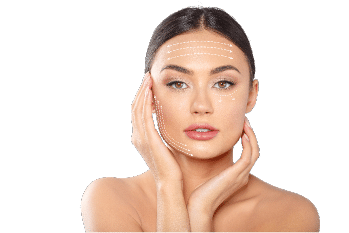While 90 percent of women experience stretch marks at some point in their lives—and some men do too—it’s still understandable how the remaining 10 percent and most men seem to avoid such a common occurrence. For those concerned about stretch marks or what you can do to reduce their appearance, discover these important factors that often contribute to their formation and what you can do to prevent them.
The top factors that contribute to the risk of developing stretch marks
Rapid weight gain
Rapid weight gain can pose a significant challenge to your skin and is a constant factor in the appearance of stretch marks. In other words, every stretch mark starts with skin stretching.
As fat or muscle is gained, the skin is forced to stretch to accommodate this growth. Unfortunately, the skin’s elasticity may limit it from stretching fast enough, leading to tears in the collagen structure beneath the skin’s surface. The result is a scar-like scar, often pink or brown in color, that emerges from the epidermis. It should be noted that this type of tear in the skin does not occur in a physical wound on the surface of the skin, but in the epidermal layer. For most pregnant women, weight gain often occurs in the sixth or seventh month of pregnancy, which is when stretch marks appear. In fact, pregnancy is the leading cause of stretch marks among women. Rapid weight gain during puberty in both men and women can lead to stretch marks, as can rapid muscle gain in bodybuilders or fat gain in people who may be overweight or obese.
Age
As we age, our skin’s natural collagen and elastin levels begin to decrease. As a result, the skin loses its strength, elasticity and ability to recover from damage due to a slower cell regeneration cycle. For these reasons, age can affect the risk of stretch marks in two ways. First, younger skin cannot stretch as much as older skin to support weight more quickly. Older skin tends to sag, causing more weight to be added before it begins to stretch. However, when stretching occurs in older skin, it is less able to repair the damage naturally, meaning the permanent appearance of stretch marks is much more common in older people. It is worth noting that lifestyle factors can also affect the speed of skin aging.
Hormones
Hormones have a significant impact on skin health. High testosterone levels are one of the main reasons why men’s skin resists stretch marks. Testosterone helps the skin’s moisture level by increasing oil production. This naturally healthier level of hydration helps support the skin’s collagen production cycle, increasing elasticity and thus reducing the risk of stretch marks. For women, estrogen has a significant effect on skin health. Balanced estrogen levels help maintain skin structure and hydration through healthy hyaluronic acid and collagen production levels for smoother, smoother, more radiant skin. The drastic changes in estrogen levels that occur during puberty, pregnancy, and menopause make the skin more prone to damage, reducing levels of natural collagen and elastin production, and resulting in thinner, less elastic skin that is prone to stretch marks.
Genetics
Genetics, like cellulite, appear to play an important role in determining the risk of developing stretch marks. If your parent or parents had stretch marks, chances are you will too. This is because traits are often passed on that cause your skin to lack elastin, the connective tissue needed to stretch the skin and prevent tearing. While there may be ways in which you can influence your risk of developing stretch marks or reduce their appearance more quickly, it is unlikely that you can avoid the genetic factor altogether.
What can you do to reduce the risk or appearance of stretch marks?
While there is no proven way to prevent stretch marks altogether, there are some steps you can take to reduce the risk or lessen the appearance of stretch marks if they do occur.
Topical treatments for STRETCH MARKS
Keeping your skin hydrated can have a significant impact on your skin’s overall ability to heal itself while maintaining its elasticity. Cutting down on alcohol consumption, using sunscreen daily, and using an effective moisturizing serum that supports the natural regeneration of skin cells are just a few ways you can help maintain skin’s hydration levels.
For the treatment of stretch marks that have already appeared, studies show that products containing retinoids—or, more specifically, at least 0.1% tretinoin—provide an effective topical treatment for stretch marks, especially newly formed ones. These retinoid-based treatments sink into the skin to initiate the natural cycles of collagen and skin cell renewal to repair damage and reduce the appearance of stretch marks in a timely manner.
Microneedling treatment for STRETCH MARKS
Microneedling may be an effective alternative for treating stretch marks in people with darker skin tones who may be prone to hyperpigmentation (discoloration) if using the latest stretch mark treatments. People with deeper skin tones tend to get less stretch marks because darker skins are more flexible than paler skin types, but that doesn’t mean stretch marks are completely avoidable. Microneedling treatments use tiny pins that create equally tiny wounds on the surface of the skin, stimulating the skin’s natural wound response, increasing collagen production, and driving new skin cells to the treated area. They are sent to replace damaged cells and reduce the appearance of cracks in time. There is less risk of affecting the skin color in the areas surrounding the treated skin.
Radiofrequency skin resurfacing treatments
For early to late stage stretch marks, Radio Frequency (RF) skin resurfacing treatments use NanoFractional RF technology to deliver thermal energy (heat) deep into the skin’s surface, which initiates the cycle of natural collagen production and helps repair damaged skin. . And gradually reduces stretch marks. Specifically, a study on the safety and efficacy of Venus Viva RF-based skin resurfacing treatments reported a significant and consistent reduction in the size of stretch marks on the thighs, buttocks, and abdomen, along with an increase in collagen and elastin levels during treatment. Area. Treatments are safe for all skin tones and sessions last between 15 and 30 minutes with minimal downtime, making it easy to fit into busy schedules.
Interested in learning more about Venus Viva’s stretch-reducing skin peel treatments?

